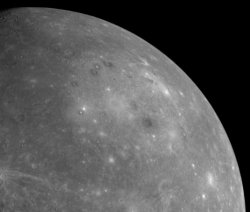
July Editorial
The volcanoes of Mercury

July Editorial
The volcanoes of Mercury
|
|
Mercury is the smallest planet (now that scientists have demoted to Pluto a'dwarf planet'). It is also the densest planet after correcting for compression (which is how much a planet is squeezed together by its own weight). Mercury is also the planet with the oldest surface, the one with the largest daily variations in surface temperature, and - because it is so close to the sun - the least explored in our Solar system. Mercury's density implies that a metal-rich core occupies at least 60% of the planet's mass, which is about double the proportion of the Earth's core. So it is not surprising that there is much interest in that planet recently. One of the key questions which the scientists have been trying to answer is the origin of Mercury’s smooth plains and the source of its magnetic field.In fact scientists have been trying to answer these two questions for some time and so put to bed a 30 year controversy. The issue of the origin of Mercury’s smooth plains began with the 1972 Apollo 16 Moon mission, which suggested that some lunar plains came from material that was ejected by large meteroite or even asteroid impacts and then formed smooth ‘ponds.’ When Mariner 10 (a NASA spacecraft which orbited Mercury in 1975) showed similar formations on Mercury, some scientists believed that the same processes were at work here as well. Others thought that Mercury’s plains came from erupted lava, but the absence of volcanic vents or other volcanic features in Mariner's images from that mission prevented any definite conclusions. But the scientific debate may now be finally resolved due to the new data supplied by the MESSENGER spacecraft. MESSENGER stands for Mercury Surface, Space Environment, Geochemistry and Ranging and is a car-sized spacecraft which was launched in 2004. In January this year the MESSENGER flew by Mercury and supplied a substantial amount of new data which has now been analysed. The new findings were published in the journal Science in a series of 11 articles (Science, 321, pp.59-94), six of which dealt specifically with analyses of the planet’s surface through its reflectance and colour variation, surface chemistry, high-resolution imaging at different wavelengths, and altitude measurements. They provide evidence that volcanic activity did indeed play a central role in shaping the surface of Mercury. The researchers at NASA found evidence of volcanic vents along the margins of the Caloris basin. The Caloris basin, with a diameter of 960 miles, is one of the Solar System's biggest impact craters, formed more than 3.8 billion years ago when a large space rock hit the planet. MESSENGER sent back images of a shield volcano, about 60 miles wide, with a distinct orange colour on the southwestern edge of the basin that may be the source for the lava that formed smooth plains inside the basin. These deposits look similar to basalt flows on the moon, but are very low in iron, suggesting an unusual rock type. Looking at the size of the plains, the scientists estimate that there is a large source of magma in Mercury's upper mantle. Inside the shield volcano, the images also revealed a kidney-shaped vent with a bright halo around it very which is similar to halos formed by explosive eruptions on Earth and the moon. The data sent by MESSENGER also suggest that Caloris has a much more complicated geologic history than previously believed. As James Head of Brown University, lead author of one of the Science reports, explaines: "By combining Mariner 10 and MESSENGER data, the science team was able to reconstruct a comprehensive geologic history of the entire basin interior. The Caloris basin was formed from an impact by an asteroid or comet during the heavy bombardment period in the first billion years of the Solar System's history. As with the lunar maria (seas), a period of volcanic activity produced lava flows that filled the basin interior. This volcanism produced the comparatively light, red material of the interior plains intermingled with impact crater deposits. Subsidence caused the surface of the Caloris floor to shorten, producing what we call wrinkle-ridges. The large troughs, or graben, then formed as a result of later uplift, and more recent impacts yielded newer craters.” NASA's Mariner 10 flew past Mercury three times, mapping 45 percent of its surface. MESSENGER has so far imaged about 20 percent more and is due to fly by Mercury again this October and once more in September 2009, before starting a year-long orbit in 2011. So watch the space .... For more up-to-date information about Messenger and its scientific results go to: http://messenger.jhuapl.edu/. |
| _______________________________ | ||||
| Home | | | Shopping | | | Database |
© Biscuit Software 2004-2015
All rights reserved